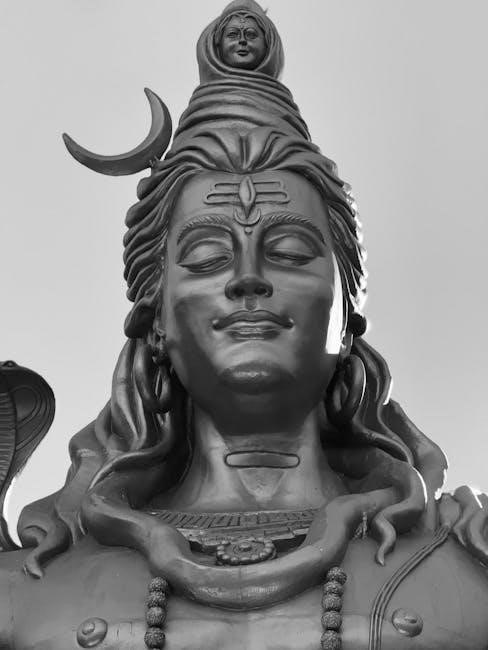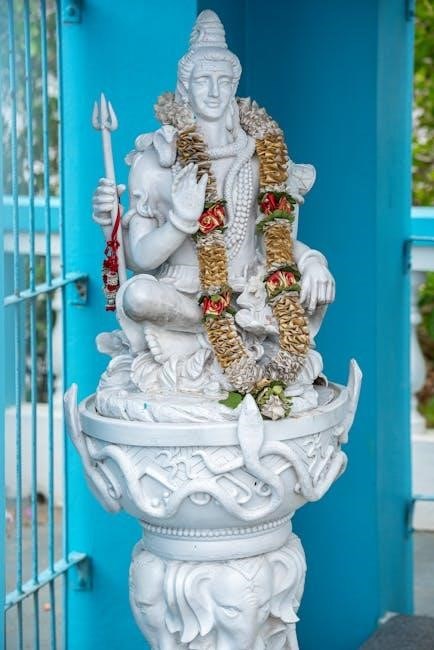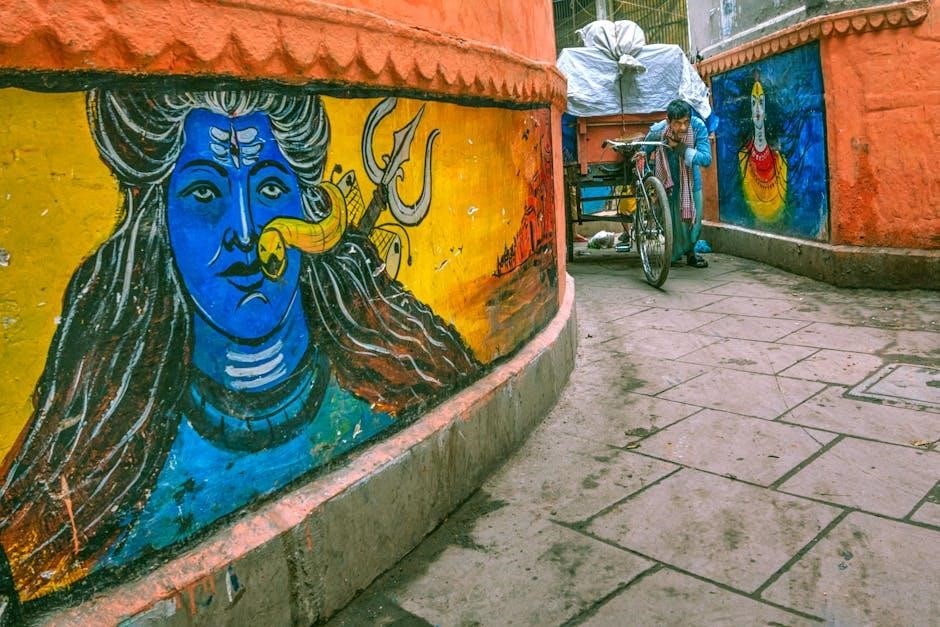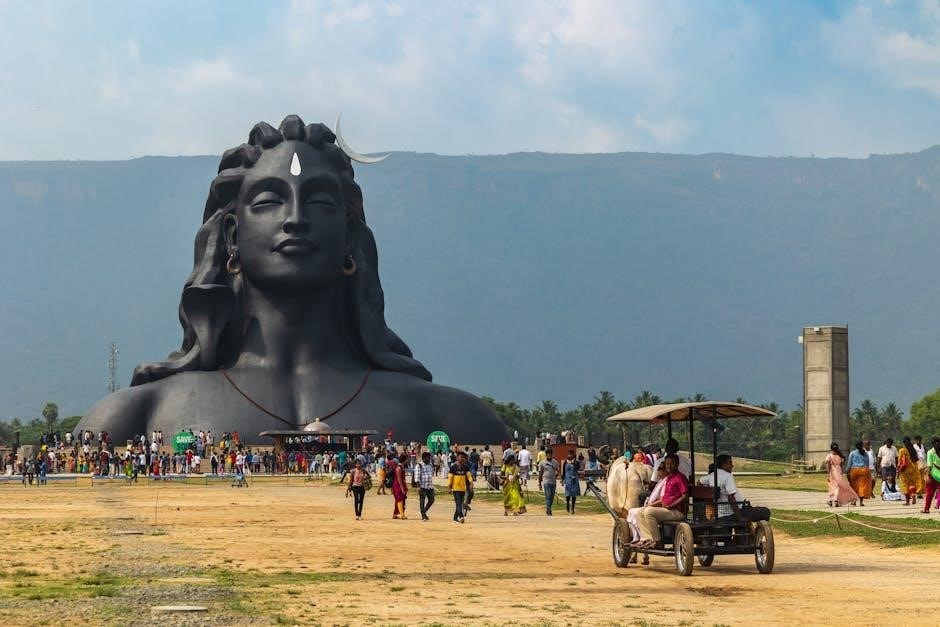The Shiva Rudram is an ancient Vedic hymn dedicated to Lord Shiva, extolling his powers and attributes. It is divided into 11 anuvakas, with the first pacifying Rudra and the rest offering eulogies. This sacred text is widely revered in Shaivism and is available as a PDF for spiritual exploration.
1.1 Overview of Shiva Rudram
The Shiva Rudram, also known as the Rudraprasna, is an ancient Vedic hymn dedicated to Lord Shiva, a central deity in Hinduism. It is a sacred text that forms part of the Taittiriya Samhita of the Yajurveda and is deeply revered in the Shaivite tradition. This hymn is divided into 11 sections, known as anuvakas, each of which serves a specific purpose in worship and spiritual practice. The Rudram is unique in its structure, blending both the fierce and benevolent aspects of Shiva’s nature, making it a comprehensive invocation of his divine attributes.
The text begins by addressing Shiva in his fearsome form, Rudra, and gradually transitions to his benevolent aspects, seeking his blessings and protection. The hymn is rich in symbolism, using imagery and metaphors to describe Shiva’s cosmic roles, such as the destroyer of evil and the protector of devotees. Its verses also enumerate Shiva’s various names, such as Neelakantha and Mrityunjaya, highlighting his multifaceted nature.
Today, the Shiva Rudram is widely studied and chanted in temples and homes, and its digital versions, such as the Shiva Rudram PDF, have made it accessible to a global audience. This ancient hymn remains a powerful tool for spiritual growth, offering devotees a profound way to connect with Shiva’s divine energy.
1.2 Importance of Shiva Rudram in Hindu Scriptures
The Shiva Rudram holds a paramount position in Hindu scriptures, particularly within the Shaivite tradition, as it is one of the most sacred and powerful hymns dedicated to Lord Shiva. It is considered a cornerstone of Vedic literature, offering a profound exploration of Shiva’s divine attributes and roles. The Rudram is not only a devotional text but also a philosophical treatise that delves into the nature of the universe and the ultimate reality.
Its significance lies in its ability to bridge the gap between the worshipper and the divine, serving as a medium for spiritual connection. The hymn is often recited in rituals and ceremonies to invoke Shiva’s blessings, ward off negativity, and seek protection. It is also valued for its therapeutic and purifying effects, believed to bring balance and harmony to those who chant it with devotion.
The availability of the Shiva Rudram in PDF format has made it accessible to a broader audience, allowing devotees to study and recite the hymn with ease. This has further amplified its importance in modern times, ensuring its relevance and continued practice in Hindu spirituality. The Rudram’s universal appeal lies in its timeless message of divine reverence and its ability to inspire spiritual growth and self-realization.

Historical and Cultural Background
The Shiva Rudram, an ancient Vedic hymn from the Yajur Veda, has a rich historical legacy spanning thousands of years. It is deeply rooted in Hindu culture, particularly in Shaivism, and has been a cornerstone of spiritual and ritual practices, preserving its relevance through generations and now accessible as a PDF.
2.1 Origin and Evolution of the Rudram
The Shiva Rudram, a sacred hymn from the Yajur Veda, traces its origins to ancient Vedic times, embodying the essence of devotion to Lord Shiva. Comprising 11 anuvakas, it reflects the evolving spiritual and cultural practices of Hinduism. Over centuries, the Rudram has been refined and interpreted by scholars, maintaining its purity and significance. Its structure, divided into namakam and chamakam, highlights the dual aspects of worship—praising Shiva’s benevolent and fearsome forms. The hymn’s evolution is marked by its incorporation into rituals and daily worship, solidifying its role in Shaivism. Available today as a PDF, the Rudram continues to inspire seekers, blending tradition with accessibility for modern spiritual exploration.
2.2 Cultural Significance in Shaivism
The Shiva Rudram holds profound cultural significance in Shaivism, serving as a cornerstone of devotion to Lord Shiva. It is not merely a hymn but a living tradition that embodies the spiritual and philosophical essence of Shaivism. The Rudram is chanted in temples, homes, and during rituals, fostering a deep connection between the devotee and the divine. Its recitation is believed to purify the environment, bring prosperity, and ward off negative energies. In Shaivite communities, the Rudram is often sung collectively, creating a sense of unity and shared spiritual experience. This practice has been passed down through generations, preserving its cultural and religious importance.
The availability of the Shiva Rudram in PDF format has further enhanced its accessibility, allowing devotees worldwide to study and recite it with ease. This modern adaptation ensures that the ancient hymn remains relevant in contemporary times, bridging the gap between tradition and technology. The Rudram’s cultural significance lies in its ability to transcend time, maintaining its relevance as a powerful tool for spiritual growth and communal worship in Shaivism.

Structure and Composition
The Shiva Rudram is structured into 11 anuvakas, each with specific themes and purposes. The first anuvaka focuses on pacifying Rudra, while the next eight extol his virtues. The ninth anuvaka is Chamaka, and the tenth and eleventh emphasize spiritual growth and liberation.
The PDF version includes Sanskrit verses, their meanings, and chants, making it a comprehensive guide for devotion and study. Its composition blends literary elegance with profound spirituality, reflecting the divine attributes of Shiva.
3.1 The Eleven Anuvakas of Shiva Rudram
The Shiva Rudram is intricately divided into eleven anuvakas, each serving a distinct purpose in the hymn. The first anuvaka is dedicated to pacifying the fierce form of Rudra, appealing for his compassion and blessings. This section sets the tone for the entire composition, emphasizing the duality of Shiva’s nature—both fearsome and benevolent.
The second to the ninth anuvakas are a series of eulogies, praising Shiva’s various attributes and powers. These sections recount his cosmic deeds, his role as the protector of the universe, and his transcendental essence. The hymns also invoke Shiva’s grace for protection from worldly challenges and spiritual growth.
The tenth and eleventh anuvakas serve as a culmination, focusing on the ultimate liberation of the soul. These final sections are deeply philosophical, reflecting on the nature of existence and the path to moksha. Together, the eleven anuvakas create a holistic narrative that balances devotion, philosophy, and spiritual aspirations.
The PDF versions of Shiva Rudram often include detailed commentaries, making it easier for devotees to understand the depth of each anuvaka. This structured composition ensures that the hymn remains accessible while preserving its sacred and intellectual richness.
3.2 Content and Themes in Each Section
The Shiva Rudram is a rich tapestry of devotion, philosophy, and cosmic imagery, with each section meticulously crafted to convey specific themes. The hymn begins by addressing Rudra in his fearsome form, seeking to pacify his wrath and invoke his benevolence. This duality of Shiva’s nature—fierce and compassionate—is a recurring motif throughout the text.
The middle sections of the Rudram are filled with eulogies, praising Shiva’s attributes and deeds. These passages highlight his role as the destroyer of evil, the protector of the universe, and the embodiment of cosmic energy. The hymn also employs numerous epithets, such as Neelakantha (the blue-throated one) and Mrityunjaya (the conqueror of death), which are central to Shaivite devotion.
Beyond devotion, the Rudram delves into philosophical themes, exploring the nature of existence and the path to liberation. The later sections emphasize the transcendental qualities of Shiva, portraying him as the ultimate reality beyond human comprehension. This blend of devotion and philosophy makes the Rudram a deeply spiritual and intellectually stimulating text.
The PDF versions of the Rudram often include detailed commentaries, providing insights into its esoteric meanings and ritual significance. These resources enhance the reader’s understanding, making the hymn accessible to both scholars and devotees alike.
Spiritual Significance
The Shiva Rudram holds profound spiritual significance, offering a deep connection with Shiva. It embodies the essence of devotion, philosophy, and self-realization, guiding seekers toward liberation. Reciting the Rudram is believed to invoke divine grace, fostering inner peace and spiritual growth;
4.1 Role of Rudram in Shaivism
The Shiva Rudram is a cornerstone of Shaivism, serving as a powerful tool for spiritual growth and devotion. It is often recited in rituals and ceremonies to invoke Shiva’s blessings and protection. The hymn is considered a direct means of connecting with the divine, embodying the principles of Shaivism. Reciting the Rudram is believed to purify the mind, bestow spiritual strength, and guide the devotee toward liberation. In Shaivist traditions, it is frequently chanted during daily worship, special ceremonies, and initiation rites. The text is also used in philosophical discussions to explore the nature of the Supreme Being. Its verses are rich in symbolism, offering insights into the duality of Shiva’s fierce and benevolent attributes. For many Shaivites, the Rudram is more than a hymn; it is a living, breathing expression of faith and a pathway to transcendence. Its recitation is often accompanied by meditation, fostering a deeper understanding of the self and the universe. As such, the Rudram remains a central and transformative text in Shaivism, bridging the gap between the earthly and the divine.
4.2 Core Philosophical Themes
The Shiva Rudram delves into profound philosophical themes central to Hindu thought, particularly in Shaivism. It explores the nature of the divine, the interplay of cosmic forces, and the ultimate reality of existence. The hymn emphasizes the duality of Shiva’s attributes, portraying him as both fearsome and benevolent, highlighting the balance of opposites in the universe.
A central theme is the concept of liberation (moksha), where the devotee seeks freedom from the cycle of birth and death. The Rudram illustrates this through Shiva’s role as both the destroyer of ignorance and the granter of wisdom. It also underscores the importance of devotion (bhakti) as a means to attain spiritual enlightenment and union with the divine.
Another key theme is the unity of existence, where Shiva is revered as the Supreme Being, pervading all creation. The hymn reflects the Vedic philosophy of oneness, where the individual self (jiva) seeks to merge with the universal self (Shiva). This philosophical underpinning makes the Rudram a rich text for both spiritual practice and intellectual exploration.
Ultimately, the Shiva Rudram serves as a bridge between the metaphysical and the practical, offering insights into the human condition and the path to transcendence. Its verses resonate with timeless truths, making it a foundational text for understanding the deeper dimensions of existence and the divine.

Key Anuvakas
The Shiva Rudram comprises 11 anuvakas, each serving a distinct purpose. The first anuvaka focuses on pacifying Rudra, while the second to ninth sections eulogize Shiva, offering obeisance and praising his divine attributes. These anuvakas collectively form a powerful hymn of devotion and philosophical reflection.
5.1 First Anuvaka: Pacifying Rudra
The first anuvaka of the Shiva Rudram is dedicated to pacifying Rudra, a fierce form of Shiva. It begins with an invocation to calm his wrath and seeks his blessings for prosperity and protection. The hymn acknowledges Rudra’s power and requests his grace to alleviate suffering. This section is deeply devotional, emphasizing the importance of appeasing Rudra to maintain balance and harmony in the universe. The verses are structured to evoke a sense of reverence and surrender, setting the tone for the rest of the Rudram. The first anuvaka is often recited in rituals to invoke Shiva’s benevolent aspect and is considered a powerful tool for spiritual purification. Its soothing and calming nature makes it a cornerstone of Shaivite worship, reflecting the duality of Shiva’s fierce and compassionate qualities. This anuvaka is also notable for its poetic beauty, blending theology with emotional depth, making it a cherished part of Hindu liturgy.
5.2 Second to Ninth Anuvakas: Eulogy and Obeisance
The second to ninth anuvakas of the Shiva Rudram are a magnificent eulogy to Lord Shiva, extolling his divine attributes and supremacy. These sections are a poetic tapestry, weaving together intricate praises of Shiva’s various forms and powers. Each anuvaka delves into different aspects of his cosmic role, from his fierce protectorship to his benevolent grace. The verses glorify Shiva as the ultimate reality, the destroyer of evil, and the source of all creation. Names like Neelakantha (the blue-throated one) and Mrityunjaya (the conqueror of death) are invoked, highlighting his unique characteristics. The hymns also emphasize Shiva’s cosmic dance, his association with mountains and rivers, and his role as the protector of the universe. These anuvakas are not just praises but also a deep expression of devotion, seeking his blessings and protection. The language is rich in imagery, making the verses both spiritually uplifting and aesthetically pleasing. By reciting these sections, devotees aim to connect with Shiva’s divine essence and experience his grace. The second to ninth anuvakas are central to Shaivite worship, reflecting the profound reverence for Shiva in Hindu spirituality. They encapsulate the essence of devotion, surrender, and the quest for divine harmony. These verses are a testament to the timeless beauty and theological depth of the Shiva Rudram.

Names and Attributes of Shiva
The Shiva Rudram PDF highlights Shiva’s divine names and attributes, such as Neelakantha and Mrityunjaya. These names symbolize his cosmic role and divine essence, reflecting his power to destroy evil and grant liberation. His attributes are central to Shaivite devotion and spiritual reverence.
6.1 Neelakantha: The Blue-Throated Shiva
Neelakantha, meaning “the blue-throated one,” is one of the most revered names of Lord Shiva, prominently featured in the Shiva Rudram PDF. This name originates from the legend of Shiva consuming the deadly poison Halahala during the churning of the cosmic ocean. The poison turned his throat blue, symbolizing his selfless act to protect the universe. In the Rudram, Neelakantha is invoked as a protector and savior, embodying divine compassion and strength.
The hymn glorifies Shiva as Neelakantha, highlighting his cosmic role and divine attributes. This name is deeply symbolic, representing Shiva’s power to neutralize negativity and bestow grace. The Shiva Rudram PDF elaborates on this aspect, offering a spiritual connection to devotees seeking protection and blessings. Through this name, Shiva is worshipped as both a fierce protector and a benevolent deity.
The reverence for Neelakantha is central to Shaivite traditions, and the Rudram serves as a primary source for understanding this divine attribute. The hymn’s verses not only eulogize Shiva but also provide a roadmap for spiritual seekers to attain divine grace. By invoking Neelakantha, devotees seek liberation from worldly bondage and eternal peace.
6.2 Mrityunjaya: Conqueror of Death
Mrityunjaya, meaning “Conqueror of Death,” is another revered name of Lord Shiva highlighted in the Shiva Rudram PDF. This name underscores Shiva’s divine power to transcend mortality and bestow immortality. The Rudram invokes Mrityunjaya as a liberator from the cycle of birth and death, offering devotees hope and solace.
The hymn glorifies Shiva as Mrityunjaya, emphasizing his role as a savior who grants liberation. This name is deeply rooted in Hindu philosophy, symbolizing the triumph over fear and the ultimate union with the divine. The Shiva Rudram PDF elaborates on this attribute, providing spiritual guidance for those seeking eternal peace.
Devotees often recite the Rudram to invoke Mrityunjaya, seeking protection from life’s adversities and the assurance of divine grace. This name embodies Shiva’s compassion and his promise to lead souls beyond the confines of mortality. Through the Rudram, Mrityunjaya becomes a beacon of hope for those striving to transcend worldly limitations.
The reverence for Mrityunjaya is profound, reflecting Shiva’s eternal promise to guide humanity toward liberation. The Shiva Rudram PDF serves as a sacred medium to connect with this divine attribute, offering solace and spiritual enlightenment to all who seek it.

Rituals and Practices
The Shiva Rudram is deeply integrated into Hindu rituals and practices, particularly in Shaivism. It is often recited during pujas, homas, and other sacred ceremonies to invoke Shiva’s blessings. The Rudram is chanted to seek prosperity, protection, and spiritual growth, with its verses believed to possess purifying effects.
The rituals involving the Rudram typically begin with purification rites, such as the recitation of the Namakam and Chamakam, which are integral parts of the hymn. Devotees often use rudraksha beads for counting during the chanting, as they are considered sacred and associated with Shiva. The PDF versions of the Rudram provide detailed guidance on the proper pronunciation and rituals.
In many temples and homes, the Rudram is recited during special occasions like Shivaratri or during personal worship. Priests and devotees prepare themselves through rituals like abhishekam (pouring sacred liquids over Shiva’s idol) before reciting the hymn. The practice is believed to create a sacred atmosphere, connecting the devotee with Shiva’s divine energy.
The Shiva Rudram PDF also highlights the significance of offerings, such as flowers, fruits, and incense, during the recitation. These offerings symbolize surrender and devotion to Shiva. The rituals emphasize the importance of mindfulness and purity of intent, ensuring the recitation’s effectiveness.
Overall, the Rudram is a cornerstone of Shaivite rituals, offering a powerful means to worship and connect with Lord Shiva. Its inclusion in daily and ceremonial practices underscores its enduring significance in Hindu spirituality.
